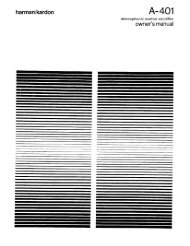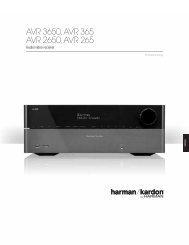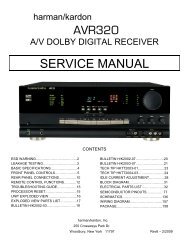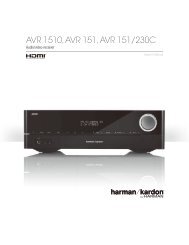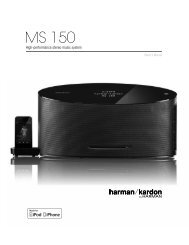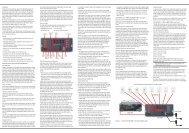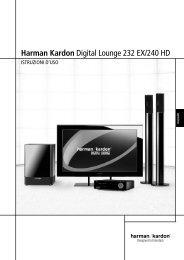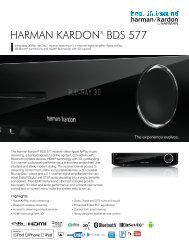Owners Manual - AVR 1600 - Harman Kardon
Owners Manual - AVR 1600 - Harman Kardon
Owners Manual - AVR 1600 - Harman Kardon
You also want an ePaper? Increase the reach of your titles
YUMPU automatically turns print PDFs into web optimized ePapers that Google loves.
There are different types of audio and video connections used<br />
to connect the receiver, the speakers, the video display, and<br />
the source devices. The Consumer Electronics Association has<br />
established the CEA ® color-coding standard. Some of these<br />
connectors are not used on the <strong>AVR</strong> <strong>1600</strong>, although they may be<br />
found on other components in your system. See Table 1.<br />
Table 1 – Connection Color Guide<br />
Audio Connections<br />
Front (FL/FR)<br />
Center (C)<br />
Surround (SL/SR)<br />
Surround Back (SBL/SBR)<br />
Subwoofer (SUB)<br />
Digital Audio Connections<br />
Coaxial<br />
Optical<br />
Video Connections<br />
Left Right<br />
White Red<br />
Green<br />
Blue Gray<br />
Component Y Green Pb Blue Pr Red<br />
Composite<br />
S-Video<br />
Yellow<br />
HDMI <br />
Connections (digital audio/video)<br />
HDMI<br />
Brown Tan<br />
Purple<br />
Orange<br />
Speaker connections<br />
Speaker cables carry an amplified signal from the receiver’s speaker<br />
terminals to each loudspeaker. They contain two wire conductors,<br />
or leads, inside plastic insulation, that are differentiated in some<br />
way, such as with colors or stripes.<br />
The differentiation preserves polarity, without which low-frequency<br />
performance can suffer. Each speaker is connected to the receiver’s<br />
speaker-output terminals using two wires, one positive (+) and one<br />
negative (–). Always connect the positive terminal on the speaker,<br />
which is usually colored red, to the positive terminal on the<br />
receiver, which is colored as indicated in the Connection Color Guide<br />
(Table 1). The negative terminals are both black.<br />
+<br />
Input<br />
The <strong>AVR</strong> <strong>1600</strong> uses binding-post<br />
speaker terminals that can accept<br />
banana plugs or bare-wire cables.<br />
Banana plugs are inserted into the hole<br />
in the middle of the terminal<br />
cap. See Figure 1.<br />
Figure 1 – Binding-Post Speaker Terminals With Banana Plugs<br />
Bare wire cables are installed as follows (see Figure 2):<br />
1. Unscrew the terminal cap until the pass-through hole is revealed.<br />
2. HOW Insert TO the USE bare THE end BINDING-POST of the wire into the SPEAKER hole. TERMINAL<br />
3. Hand-tighten COMMENT the UTILISER cap LA until BORNE the DES HAUT-PARLEURS wire is held DE CONNEXION snugly.<br />
CÓMO USAR EL TERMINAL DE ALTAVOZ DE POSTE DE SUJECIÓN<br />
1 2 3<br />
Figure 2 – Binding-Post Speaker Terminals With Bare Wires<br />
Always connect colored (+) terminal on <strong>AVR</strong> to red (+) terminal<br />
on speaker; and black (–) to black (–).<br />
Branchez toujours la borne (+) colorée sur <strong>AVR</strong> à la borne (+) rouge sur le haut-parleur;<br />
et la noire (–) à la noire (–).<br />
Conecte siempre el terminal de color (+) en el <strong>AVR</strong> al terminal rojo (+) en el altavoz;<br />
y el negro (–) al negro (–).<br />
Subwoofer<br />
The subwoofer is dedicated to the low frequencies (bass), which<br />
require more power. To obtain the best results, most speaker<br />
manufacturers offer powered subwoofers that contain their own<br />
amplifier. Usually, a line-level (nonamplified) connection is made<br />
from the receiver’s Subwoofer Output to a corresponding jack<br />
on the subwoofer, as shown in Figure 3.<br />
Although the purple subwoofer outputs look similar to full-range<br />
analog audio jacks, they are filtered to allow only the low frequencies<br />
to pass. Don’t connect these outputs to any other devices.<br />
Figure 3 – Subwoofer<br />
COnnECTiOnS<br />
Preout<br />
Subwoofer<br />
connectInG Source DeVIceS<br />
to tHe aVr<br />
Audio and video signals originate in “source devices,” including<br />
your Blu-ray Disc or DVD player, CD player, DVR (digital video<br />
recorder) or other recorder, tape deck, game console, cable or<br />
satellite television box or MP3 player. The <strong>AVR</strong>’s tuner also counts<br />
as a source, even though no external connections are needed,<br />
other than the FM and AM antennas and the SIRIUS tuner module.<br />
Separate connections are required for the audio and video portions<br />
of the signal, except for digital HDMI connections. The types of<br />
connections used depend upon the capabilities of the source device<br />
and video display.<br />
audio connections<br />
There are two types of audio connections: digital and analog.<br />
Digital audio signals are required for listening to sources encoded<br />
with digital surround modes, such as Dolby Digital and DTS, or for<br />
noncompressed PCM digital audio. There are three types of digital<br />
audio connections: HDMI, coaxial and optical. Do not use more<br />
than one type of digital audio connection for each source<br />
device. However, it’s okay to make both analog and digital audio<br />
connections to the same source.<br />
note: HDMI signals may carry both audio and video. If your<br />
video display device has an HDMI input, make a single HDMI<br />
connection from each source device to the <strong>AVR</strong>. Usually, a<br />
separate digital audio connection is not required. Turn the<br />
volume on your television all the way down.<br />
Digital audio<br />
The <strong>AVR</strong> <strong>1600</strong> is equipped with three HDMI (High-Definition<br />
Multimedia Interface) inputs, and one output. HDMI technology<br />
enables digital audio and video information to be carried using<br />
a single cable, delivering the highest quality picture and sound.<br />
The <strong>AVR</strong> <strong>1600</strong> uses HDMI (V.1.3a with Deep Color) technology and<br />
is capable of processing both the audio and video components<br />
of the HDMI data, minimizing the number of cable connections<br />
in your system. The <strong>AVR</strong> <strong>1600</strong> implements Deep Color, which<br />
increases by an order of magnitude the shades of color that can<br />
be displayed, and the latest lossless multichannel audio formats,<br />
including Dolby TrueHD and DTS-HD Master Audio.<br />
15



